August 2024
The global nasal drug delivery technology market size is accounted at USD 88.85 billion in 2025 and is forecasted to hit around USD 168.59 billion by 2034, representing a CAGR of 7.38% from 2025 to 2034. The North America market size was estimated at USD 28.94 billion in 2024 and is expanding at a CAGR of 7.39% during the forecast period. The market sizing and forecasts are revenue-based (USD Million/Billion), with 2024 as the base year.
The global nasal drug delivery technology market size was calculated at USD 82.68 billion in 2024 and is predicted to increase from USD 88.85 billion in 2025 to approximately USD 168.59 billion by 2034, expanding at a CAGR of 7.38% from 2025 to 2034. Because of the nasal mucosa's strong vascularization, medicines can be absorbed into the bloodstream through the nasal route with a rapid onset of action.
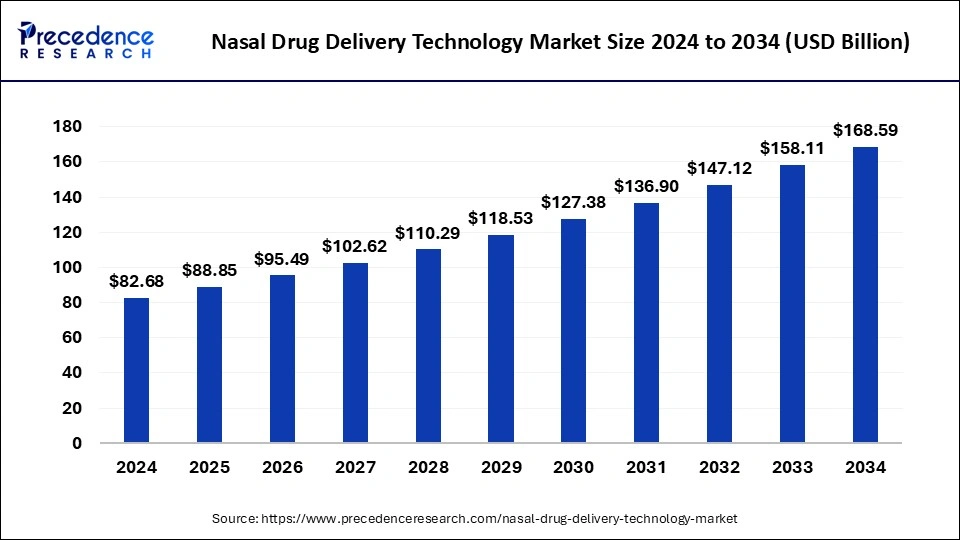
The U.S. nasal drug delivery technology market size was evaluated at USD 10.13 billion in 2024 and is projected to be worth around USD 21.40 billion by 2034, growing at a CAGR of 7.77% from 2025 to 2034.
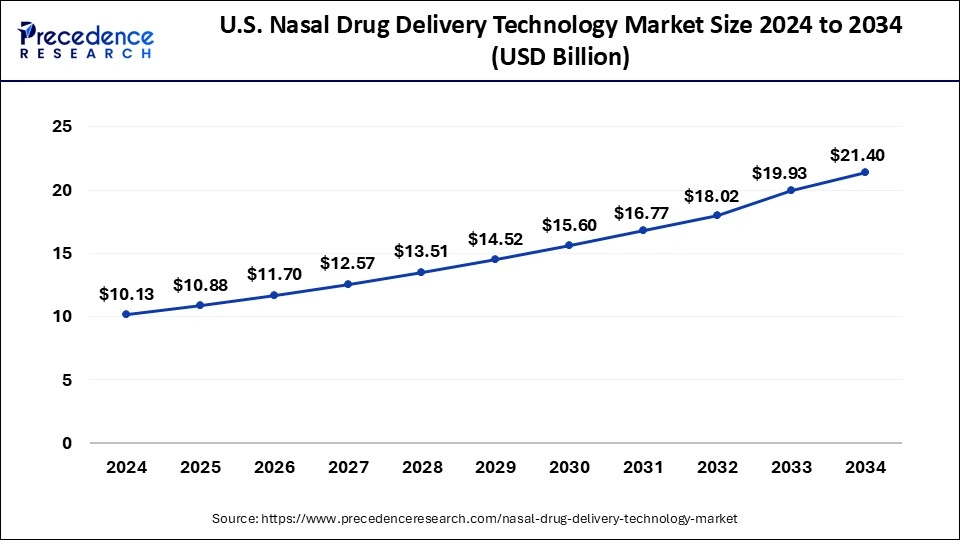
North America held the largest share of the nasal drug delivery technology market in 2024. Due to its increased efficacy and convenience of administration, patients are beginning to favor nasal medication delivery more and more. This technique increases medication bioavailability by avoiding the liver's first-pass processing and delivering a quick start of the action. Self-administration and home healthcare are becoming more and more popular, especially for long-term illnesses like asthma and chronic obstructive pulmonary disease (COPD). The ease of use of nasal drug delivery devices and their lack of invasiveness are factors supporting this growth. The market is growing as a result of advancements in medication formulations and delivery systems. Treatments are becoming increasingly easy to use and effective thanks to developments in nasal sprays, powders, gels, and drops.
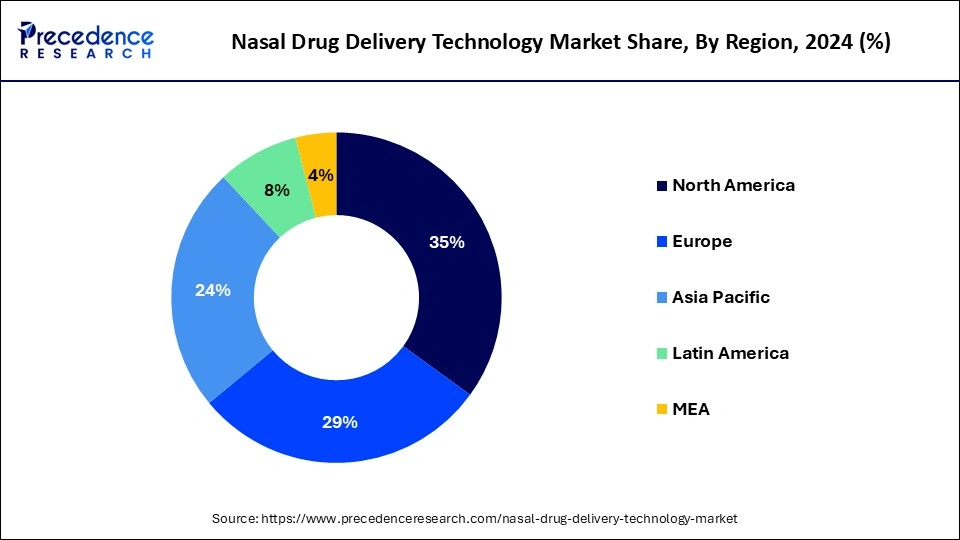
Asia Pacific is expected to host the fastest-growing nasal drug delivery technology market during the projected period. Chronic respiratory conditions like asthma, COPD, and allergic rhinitis are becoming more common in the Asia Pacific region. Due to their ability to provide effective and quick drug absorption, nasal drug delivery technologies are becoming more and more popular. The region's governments are actively pushing public awareness campaigns about nasal medicine delivery systems' advantages and respiratory health. The biopharmaceutical industry in the area is investing more money in research and development. These businesses are concentrated on creating cutting-edge and novel nasal drug delivery devices, like metered dosage inhalers (MDIs) and dry powder inhalers (DPIs), which are anticipated to propel market expansion.
Nasal drug delivery technique is the process of administering medication via the nose. Because of its potential for quick medication absorption and beginning of action, non-invasiveness, and increased patient compliance, this approach is becoming more and more common. Compared to injections, nasal administration is non-invasive, which improves patient comfort and compliance. Nasal drug administration allows for speedier therapeutic benefits by avoiding first-pass metabolism and the gastrointestinal tract.
The effectiveness and range of nasal medication delivery are being improved by ongoing developments in formulation technology and delivery tools. The desire for speedy and efficient treatment options is causing conditions including diabetes, cardiovascular illnesses, and chronic pain to drive demand for nasal medication delivery systems.
Due to growing therapeutic uses, growing patient and healthcare provider acceptability, and technological improvements, the nasal drug delivery technology market is expected to increase significantly. Strategic partnerships in conjunction with innovations in medicine formulations and delivery systems will further improve market growth possibilities.
Due to its advantages over conventional drug delivery techniques, technical developments, and an increasing need for non-invasive and quick-acting treatments, the nasal drug delivery technology market is expanding rapidly. In the upcoming years, it is anticipated that this growth trajectory will be maintained by ongoing innovation and wise industry decisions.
| Report Coverage | Details |
| Market Size by 2034 | USD 168.59 Billion |
| Market Size in 2025 | USD 88.85 Billion |
| Market Size in 2024 | USD 82.68 Billion |
| Market Growth Rate from 2025 to 2034 | CAGR of 7.38% |
| Largest Market | North America |
| Base Year | 2024 |
| Forecast Period | 2025 to 2034 |
| Segments Covered | Dosage Form, Container Type, Distribution Channel, Therapeutic Application, and Regions |
| Regions Covered | North America, Europe, Asia-Pacific, Latin America, and Middle East & Africa |
Rising geriatric population
Chronic problems like diabetes, heart disease, and respiratory disorders are more common among the elderly. Nasal drug delivery is a practical and non-invasive method for treating these illnesses, which frequently call for long-term therapy. For elderly individuals who might require prompt medicine administration or immediate symptom alleviation, nasal drug delivery offers quick absorption and a prompt commencement of action.
As nasal medicine delivery is non-invasive and convenient, elderly individuals may be more likely to comply, which could improve the way their medical conditions are managed. The need for easy-to-use nasal drug delivery systems that may be used at home is increasing due to the trend towards home healthcare services, which is being pushed by the goal of lowering hospital visits and healthcare expenditures.
High development costs
It takes significant investigation and creativity to create formulations that guarantee the drug's stability, effectiveness, and safety when taken via nasal injection. Thorough testing and validation procedures are necessary to guarantee adherence to regulatory standards established by organizations such as the European Medicines Agency (EMA) and the U.S. Food and Drug Administration (FDA).
Specialized tools and technologies are needed to manufacture nasal drug delivery devices, and these can be expensive to buy and maintain. It is costly but necessary to get patents for novel technologies and formulas in order to safeguard intellectual property and gain a competitive edge. Expenses related to obtaining a license for technology or formulas from other businesses or academic institutions.
Therapeutic advancements
The drug's bioavailability and absorption are enhanced by these preparations. They can be designed to deliver medications at a regulated pace, increasing the effectiveness of treatment and lowering adverse effects. The efficacy of the medication is increased by these devices because they provide a more accurate and consistent dose distribution to the nasal cavity. Vaccines administered by nasal administration have the ability to elicit both systemic immunity and a mucosal immune response, offering more complete protection against illnesses.
Novel approaches to formulation and distribution have made it possible to administer biologics through the nose, which was previously difficult because of their enormous molecular size and instability. The effectiveness and safety of nasal drug delivery methods are being demonstrated by more clinical trials and real-world research, giving patients and healthcare professionals greater confidence.
The nasal spray segment held the largest share of the nasal drug delivery technology market in 2023. Because of its advantages over other drug delivery systems, the nasal spray section of the nasal drug delivery technology industry is a substantial and expanding market. Due to the increasing prevalence of chronic diseases, increased desire for non-invasive delivery techniques, and technical improvements, the nasal spray segment of the nasal medication delivery technology market is expected to experience considerable expansion. Businesses are concentrating on creating cutting-edge nasal sprays that provide more ease, patient compliance, and efficacy. It is anticipated that the nasal drug delivery technology market will grow, with substantial contributions from makers of medical devices and pharmaceuticals. Future advancements in this market will probably be driven by the emphasis on personalized medicine and the growth of therapeutic applications.
The nasal drop segment is expected to grow at a significant rate in the nasal drug delivery technology market during the forecast period. In the market for nasal drug delivery technologies, the nasal drop segment is expanding at a rapid pace. This market sector is included in the non-pressurized container category, which also includes nasal sprays, gels, and powders. Nasal drops are becoming more and more popular since they are simple to use and work well at administering medication straight into the nasal canal, which guarantees quick absorption and activity. The aging population, the rise in chronic respiratory diseases, including COPD and asthma, and the growing patient demand for effective and non-invasive drug delivery techniques are the main factors driving this expansion.
The non-pressurized container segment led the nasal drug delivery technology market in 2023. Medication is administered directly into the nasal cavity using non-pressurized containers, which eliminates the need for pressurization devices or propellants. These are frequently available in a variety of shapes and sizes, including squeeze bottles, spray bottles, and droppers. Because of the growing patient desire for non-invasive administration methods, the expanding application of nasal delivery for a variety of therapeutic areas, and technological improvements, the non-pressurized container segment of the nasal drug delivery market is likely to increase rapidly. Creation of novel materials and designs that increase patient compliance and delivery efficiency. Firms' ongoing attempts to obtain regulatory approval for novel formulations and delivery methods.
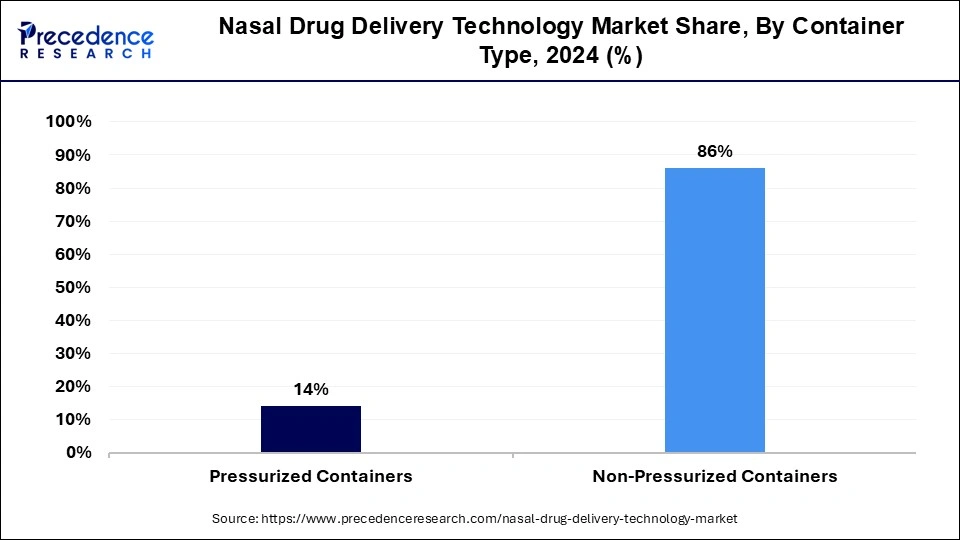
The pressurized container segment is expected to grow rapidly in the nasal drug delivery technology market in the upcoming years. Aerosols or sprays containing drugs are administered via the nasal route using pressurized canisters. To guarantee the exact and regulated delivery of the medication, these containers keep the pressure at a constant level. The growing number of people suffering from allergies, respiratory disorders, and congestion of the nose is increasing the need for effective and convenient drug delivery systems. Metered-dose inhalers (MDIs) and sophisticated aerosol technologies are two examples of innovative pressurized container designs that are increasing efficacy and user compliance. Within the nasal drug delivery technology market, a sizeable and expanding category is the pressurized container market. It has many advantages, such as accurate dosage, consistency, and ease of use for the user.
The retail pharmacies segment is expected to grow rapidly in the nasal drug delivery technology market during the forecast period. The nasal drug delivery technology market is dominated by the retail pharmacy sector. Nasal medication delivery has a number of benefits, such as simplicity in administration, quick beginning of action, and prevention of first-pass metabolism. Because of these advantages, nasal drug delivery is a popular method for administering prescription and over-the-counter (OTC) drugs, which are often supplied through retail pharmacies. The retail pharmacy industry plays a crucial role in the market by acting as a conduit for the distribution of nasal pharmaceuticals and by offering patient education and assistance. Nasal sprays, nasal drops, and nasal powders are among the drug delivery methods that are primarily distributed through retail pharmacies. Patients frequently choose to buy these medications from retail pharmacies because they are more accessible and convenient.
The hospital pharmacies segment is expected to grow rapidly in the nasal drug delivery technology market during the forecast period. Patients usually use hospital pharmacies as their main source of prescription drug supply. They either give patients their nasal medications directly or provide them to medical professionals to administer. Nasal medication items are efficacious, safe, and of high quality, thanks to hospital pharmacies. To preserve the integrity of these drugs, they handle, dispense, and store them according to stringent guidelines.
In hospital settings, pharmacists are essential in teaching patients about appropriate nasal drug administration methods, possible adverse effects, and following treatment plans. It's possible that certain hospital pharmacies are working on projects involving the advancement of nasal drug delivery technologies. They might take part in clinical trials to assess novel formulations or modes of administration.
The rhinitis segment dominated the nasal drug delivery technology market in 2023. Within the nasal drug delivery technology market, rhinitis a common illness marked by inflammation of the nasal mucous membranes presents a sizable market segment. The increasing incidence of rhinitis which encompasses allergic, non-allergic, and infectious forms around the world is driving this market. There is an increasing need for effective and convenient treatment alternatives for rhinitis, as a considerable proportion of the population suffers from this condition.
This motivates efforts in research and development on nasal medication delivery technology. Regulatory clearances are a major factor in determining the market environment. Strict laws guarantee the effectiveness and safety of nasal medication delivery systems and formulations, which has an effect on new product development and market share.
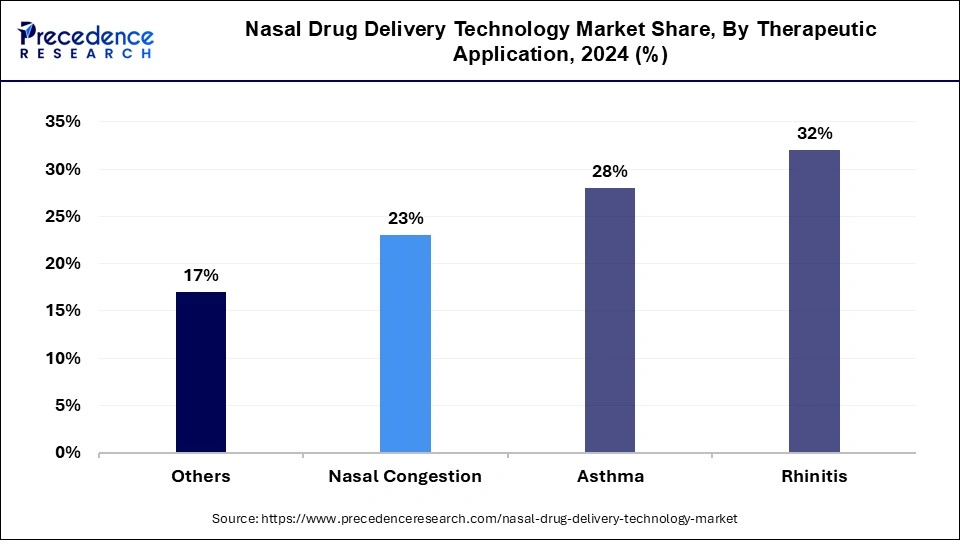
The asthma segment is expected to grow at a notable rate in the nasal drug delivery technology market during the forecast period. In the market for nasal drug delivery technologies, the asthma segment relates to the creation and application of nasal delivery systems made expressly to provide medication for treating asthma.
Nasal drug administration has drawn interest as a straightforward and non-invasive way to administer drugs directly to the respiratory system's intended site of action, which makes it very important for controlling asthma symptoms. The safety profile of asthma medicines can be improved by directly delivering pharmaceuticals to the nasal mucosa, which can minimize systemic exposure and lower the risk of systemic adverse effects that are frequently linked with oral medications.
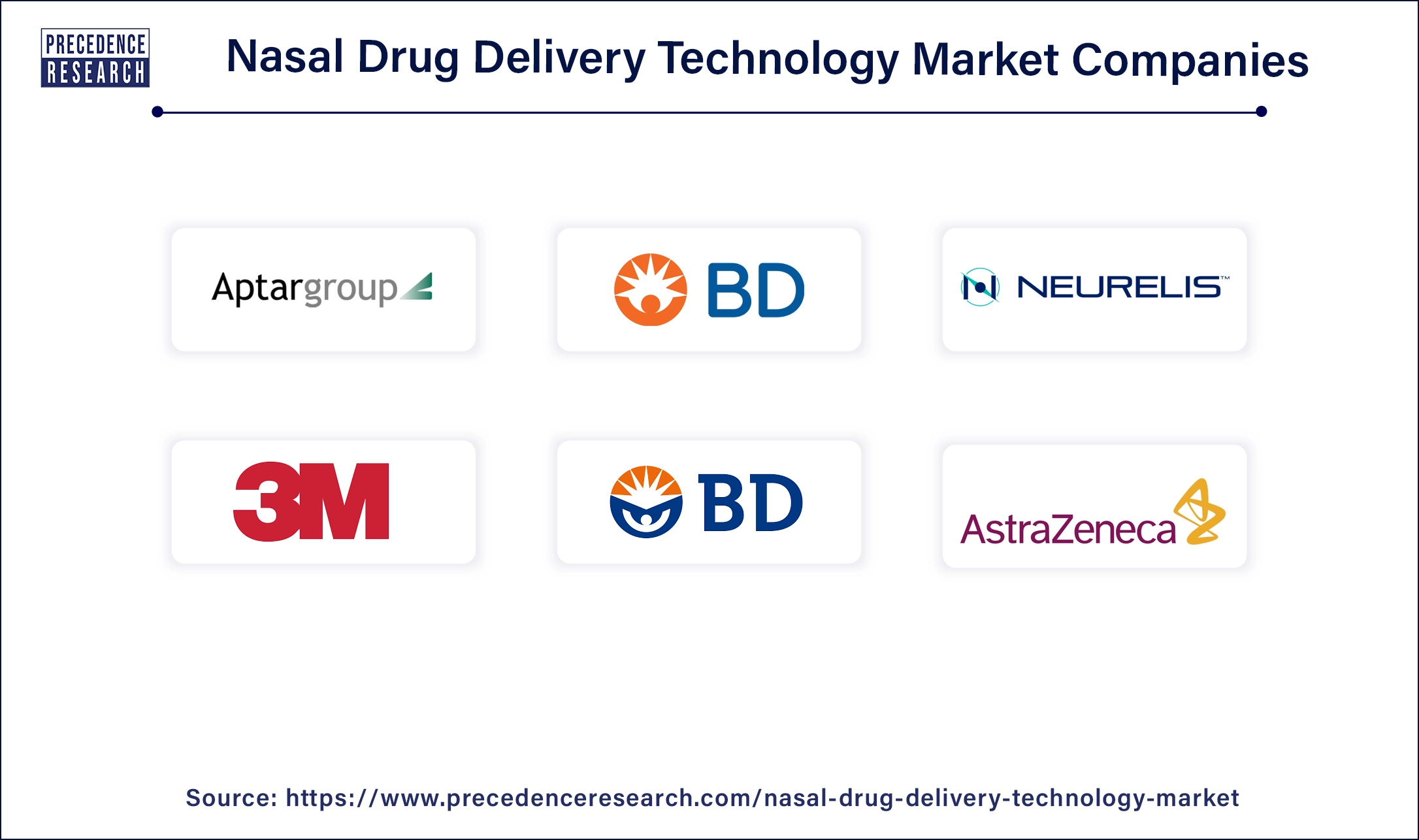
By Dosage Form
By Container Type
By Distribution Channel
By Therapeutic Application
By Geography
For inquiries regarding discounts, bulk purchases, or customization requests, please contact us at sales@precedenceresearch.com
No cookie-cutter, only authentic analysis – take the 1st step to become a Precedence Research client
August 2024
September 2024
August 2024
June 2023